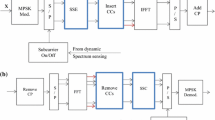Abstract
Recently, increasing attention is paid to improving the spectrum utilization in cognitive OFDM systems. To enable coexistence between secondary users and primary users, a scheme, called as extended active interference cancellation (EAIC), was proposed for the effective sidelobe suppression of OFDM signals. However, with the EAIC method, the cancellation signals cause self-interferences to OFDM data subcarriers, which seriously degrades the symbol-error-rate performance, especially, when a high order modulation is used. In this paper, we analyze the self-interferences and formulate the minimization of both the total sidelobe power and the self-interferences as a optimization problem, which could be solved by least square method with acceptable complexity for OFDM communication systems nowadays. Simulation results show that the proposed EAIC-IC scheme provides a good sidelobe suppression performance of about 38.0 dB with signal-to-noise ratio loss less than 0.10 dB at symbol-error-rate of 10 − 3 when 64 QAM modulation is employed. Moreover, the proposed EAIC-IC scheme can provide an arbitrary tradeoff between the sidelobe suppression and the symbol-error-rate performance via adjusting the constraint parameter.











Similar content being viewed by others
References
Mitola J (1999) Cognitive radio for flexible mobile multimedia communications. In: Proceedings of IEEE mobile multimedia conference, pp 3–10
Haykin S (2005) Cognitive radio: brain-empowered wireless communications. IEEE J Sel Areas Commun 23(2):201–220
Weiss T, Jondral F (2004) Spectrum pooling: an innovative strategy for enhancement of spectrum efficiency. IEEE Commun Mag 42:8–14
Berthold U, Jondral FK (2005) Guidelines for designing OFDM overlay systems. In: Proceedings of 1st IEEE symposium new frontiers dynamic spectrum access networks, pp 626–629
Tang H (2005) Some physical layer issues of wide-band cognitive radio systems. In: Proceedings of 1st IEEE symposium new frontiers dynamic spectrum access networks, pp 151–159
Weiss T, Hillenbrand J, Krohn A, Jondral FK (2004) Mutual interference in OFDM-based spectrum pooling systems. In: Proceedings of IEEE vehicular technology conference, vol 4, pp 1873–1877
Yamaguchi H (2004) Active interference cancellation technique for MB-OFDM cognitive radio. In: Proceedings of IEEE European microwave conference, vol 2, pp 1105–1108
Brandes S, Cosovic I, Schnell M (2005) Sidelobe suppression in OFDM systems by insertion of cancellation carriers. In: Proceedings of IEEE vehicular technology conference, vol 1, pp 152–156
Brandes S, Cosovic I, Schnell M (2006) Reduction of out-of-band radiation in OFDM systems by insertion of cancellation carriers. IEEE Commun Lett 10(6):420–422
Brandes S, Cosovic I, Schnell M (2005) Reduction of out-of-band radiation in OFDM based overlay systems. In: Proceedings of 1st IEEE symposium new frontiers dynamic spectrum access networks, pp 662–665
Mahmoud HA, Arslan H (2008) Sidelobe suppression in OFDM-based spectrum sharing systems using adaptive symbol transition. IEEE Commun Lett 12(2):133–135
Cosovic I, Brandes S, Schnell M (2006) Subcarrier weighting: a method for sidelobe suppression in OFDM systems. IEEE Commun Lett 10(6):444–446
Cosovic I, Brandes S, Schnell M (2005) A technique for sidelobe suppression in OFDM systems. In: Proceedings of IEEE global telecommunications conference, vol 1
Cosovic I, Mazzoni T (2007) Sidelobe suppression in OFDM spectrum sharing systems via additive singal method. In: Proceedings of IEEE vehicular technology conference, pp 2692–2696
Pagadarai S, Rajbanshi R, Wyglinski AM, Minden GJ (2008) Sidelobe suppression for OFDM-based cognitive radios using constellation expansion. In: Proceedings of IEEE wireless communications and networking conference, pp 888–893
Wang ZQ, Qu DM, Jiang T, He YJ (2008) Spectral sculpting for OFDM based opportunistic spectrum access by extended active interference cancellation. In: Proceedings of IEEE global telecommunications conference, pp 888–893
Gander W (1981) Least squares with a quadratic constraint. Numer Math 36:291–307
IEEE P802.15-03/268r3 (2004) Multi-band OFDM physical layer proposal for IEEE 802.15 tast group3a
Author information
Authors and Affiliations
Corresponding author
Additional information
This work was supported in part by the National Natural Science Foundation of China (No. 60702039), the International S&T Cooperation Program of China (No. 2008DFA12100), and the National High Technology Development 863 Program of China under Grant 2009AA011803.
Rights and permissions
About this article
Cite this article
Wang, Z., Qu, D., Jiang, T. et al. Sidelobe Suppression Using Extended Active Interference Cancellation with Self-Interferences Constraint for Cognitive OFDM Systems. Mobile Netw Appl 16, 544–552 (2011). https://doi.org/10.1007/s11036-010-0242-x
Published:
Issue Date:
DOI: https://doi.org/10.1007/s11036-010-0242-x




